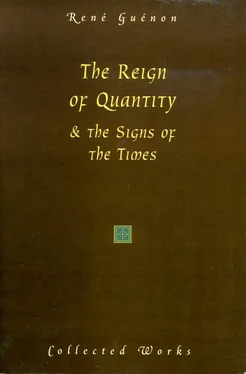23
Time Changed into Space
In an earlier chapter it was stated that in a certain sense time consumes space, and that it does so in consequence of the power of contraction contained in it, which tends continuously to reduce the spatial expansion to which it is opposed: but time, in its active opposition to the antagonistic principle, unfolds itself with ever-growing speed, for it is far from being homogenous, as people who consider it solely from a quantitative point of view imagine, but on the contrary it is ‘qualified’ at every moment in a different way by the cyclical conditions of the manifestation to which it belongs. The acceleration of time is becoming more apparent than ever in our day, because it becomes exaggerated in the final periods of a cycle, but it nevertheless actually goes on constantly from the beginning of the cycle to the end: it can therefore be said not only that time compresses space, but also that time is itself subject to a progressive contraction, appearing in the proportionate shortening of the four Yugas , with all that this implies, not excepting the corresponding diminution in the length of human life. It is sometimes said, doubtless without any understanding of the real reason, that today men live faster than in the past, and this is literally true; the haste with which the moderns characteristically approach everything they do being ultimately only a consequence of the confused impressions they experience.
If carried to its extreme limit the contraction of time would in the end reduce it to a single instant, and then duration would really have ceased to exist, for it is evident that there can no longer be any succession within the instant. Thus it is that ‘time the devourer ends by devouring itself’, in such a way that, at the ‘end of the world’, that is to say at the extreme limit of cyclical manifestation, ‘there will be no more time’; this is also why it is said that ‘death is the last being to die’, for wherever there is no succession of any kind death is no longer possible. [101] Nevertheless, since Yama is designated in Hindu tradition as the ‘first death’, and is assimilated to ‘Death’ itself (Mṛtyu ), or, if the language of the Islamic tradition is preferred, to the ‘Angel of Death’, it will be seen that in this as in so many other cases the ‘first’ and the ‘last’ meet and become more or less identified through the correspondence between the two extremities of the cycle.
As soon as succession has come to an end, or, in symbolical terms, ‘the wheel has ceased to turn’, all that exists cannot but be in perfect simultaneity; succession is thus as it were transformed into simultaneity, and this can also be expressed by saying that ‘time has been changed into space’. [102] Wagner wrote in Parsifal : ‘Here, time is changed into space,’ the place referred to being Montsalvat, which represents the ‘center of the world’ (this point will be returned to shortly); there is however little likelihood that he really understood the profound meaning of the words, for he scarcely seems to deserve the reputation of being an ‘esoterist’ attributed to him by some people; everything really esoteric found in his works properly belongs to the ‘legends’ used by him, the meaning of which he all too often merely diminished.
Thus a ‘reversal’ takes place at the last, to the disadvantage of time and to the advantage of space: at the very moment when time seemed on the point of finally devouring space, space in its turn absorbs time; and this, in terms of the cosmological meaning of the Biblical symbolism, can be said to be the final revenge of Abel on Cain.
There is a sort of ‘prefiguration’ of the absorption of time by space, of which its authors are no doubt quite unconscious, in the recent physico-mathematical theories that treat the ‘space-time’ complex as a single and indivisible whole, these theories incidentally usually being interpreted inaccurately, when they are regarded as treating time as if it were a ‘fourth dimension’ of space. It would be more correct to say that time is treated as being comparable to a ‘fourth dimension’ only in the sense that in equations of movement it plays the part of a fourth coordinate added to the three representing the three dimensions of space; and it is important to note that this implies the geometrical representation of time in a rectilinear form, the insufficiency of which has previously been pointed out, though it could not be otherwise in theories so purely quantitative in character as those in question. But this last statement, while it corrects up to a certain point the ‘popular’ explanation, is nevertheless still inexact. In reality, that which plays the part of a fourth coordinate is not time, but something that the mathematicians call ‘imaginal time’; [103] In other words, if the three coordinates of space are x , y , and z , the fourth coordinate is not t , which designates time, but the expression t √-1.
and this expression, itself no more than a singularity of language arising from the use of an entirely ‘conventional’ notation, here takes on a rather unexpected significance. Indeed, to say that time must become ‘imaginal’ in order to become assimilable to a fourth dimension of space, is really and truly as much as to say that what must happen is that time should actually cease to exist as such, or in other words that the transmutation of time into space is in fact only realizable at the ‘end of the world’. [104] It is of interest to note that, although the ‘end of the world’ is commonly spoken of as the ‘end of time’, it is never spoken of as the ‘end of space’; this observation might seem insignificant to those who only see things superficially, nonetheless it is actually very significant.
The conclusion may be drawn that it is quite useless to look for anything that might be a ‘fourth dimension’ of space under the conditions of the present world, and this has at least the advantage that it cuts short all the ‘neo-spiritualist’ divagations briefly referred to earlier; but is it necessary also to conclude that the absorption of time by space must necessarily take the form of the addition of a supplementary dimension to space, or is that too only a ‘figure of speech’? All that it is possible to say about this is that when the expansive tendency of space is no longer opposed and restrained by the compressive tendency of time, then space must naturally, in one way or another, undergo a dilatation such as will raise its indefinity to a higher power; [105] On the successive powers of the indefinite, see The Symbolism of the Cross , chap. 12.
but it should scarcely be necessary to add that this occurrence cannot be represented by any image borrowed from the corporeal domain. Indeed, since time is one of the determining conditions of corporeal existence, it is evident that its suppression is by itself sufficient to cause everything to be taken right out of the world; the being is then in what has been called elsewhere an extracorporeal ‘prolongation’ of the same individual state of existence as that of which the corporeal world represents but a mere modality: this also serves to indicate that the end of the corporeal world is by no means the end of the said state of existence considered in its integrality. Furthermore, the end of a cycle such as that of the present humanity is really only the end of the corporeal world itself in quite a relative sense, and only in relation to the possibilities that have been included in the cycle and so have completed their development in corporeal mode; but in reality the corporeal world is not annihilated, but ‘transmuted’, and it immediately receives a new existence, because, beyond the ‘stopping-point’ corresponding to the unique instant at which time is no more, ‘the wheel begins to turn again for the accomplishment of another cycle’.
Читать дальше











